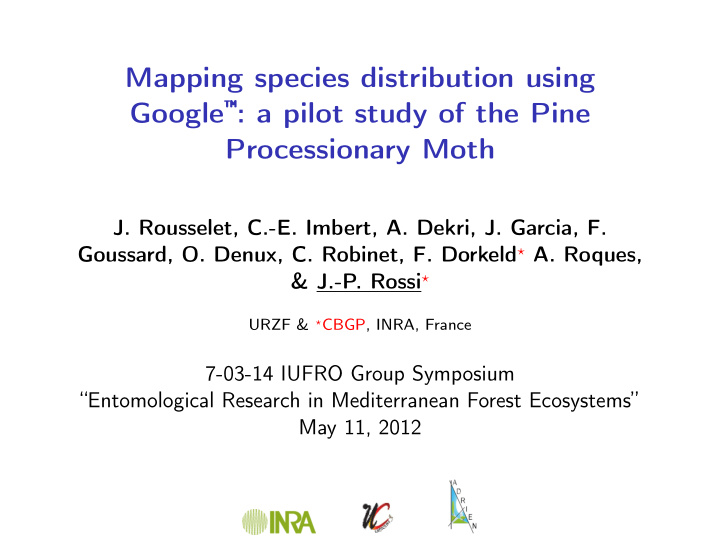



Mapping species distribution using Google ™ : a pilot study of the Pine Processionary Moth J. Rousselet, C.-E. Imbert, A. Dekri, J. Garcia, F. Goussard, O. Denux, C. Robinet, F. Dorkeld ⋆ A. Roques, & J.-P. Rossi ⋆ URZF & ⋆ CBGP, INRA, France 7-03-14 IUFRO Group Symposium “Entomological Research in Mediterranean Forest Ecosystems” May 11, 2012
Objectives Assessing species distribution over large regions Documenting the presence/absence of the species Monitoring species expansion Climate change Biological invasion Question Can we take advantage of free databases such as Google Maps ™ to improve our knowledge of species distribution ?
Methods Comparing field data with in silico data derived from Google Maps ™ Assessing possible scale effects by working at 2 contrasted spatial scales Subject species : the pine processionary moth Thaumetopoea pityocampa
Google Street View ™ and the Google cars Google ™ = a set of services accessible from the web for free Google Maps ™ and Google Earth ™ = Mapping and geospatial resources Google Street = technology providing panoramic views from positions along many streets in the world The Google cars explore the streets and take pictures used to generate panoramic views
Google Street View ™ and the Google cars Google Street = technology providing panoramic views from positions along many streets in the world
Google Street View ™ and the Google cars Google Street = technology providing panoramic views from positions along many streets in the world
Study sites A large study area of ca. 240 × 300 km ( ≃ 73 000 km 2 ) A smaller study area of 22 × 22 km (484 km 2 )
Sampling for presence/absence Studied area discretised in : 291 cells of 16 × 16 km size 121 cells of 2 × 2 km size
Sampling Traditional sampling Each cell was explored by well trained people (car driving) and the presence of PPM nest recorded. All roads were run through. Sampling PPM using Google Maps ™ and Google Street View ™ Each cell was explored using the Google database by means of visual exploration of the available panoramic views.
Each cell was explored using Google Maps ™ and Google Street View ™
Each cell was explored using Google Maps ™ and Google Street View ™
Each cell was explored using Google Maps ™ and Google Street View ™
Each cell was explored using Google Maps ™ and Google Street View ™
Each cell was explored using Google Maps ™ and Google Street View ™
Each cell was explored using Google Maps ™ and Google Street View ™
Each cell was explored using Google Maps ™ and Google Street View ™
Each cell was explored using Google Maps ™ and Google Street View ™
Each cell was explored using Google Maps ™ and Google Street View ™
Each cell was explored using Google Maps ™ and Google Street View ™
Each cell was explored using Google Maps ™ and Google Street View ™
Each cell was explored using Google Maps ™ and Google Street View ™
Large scale study (cell = 16 × 16 km) Field data Google-derived data
Large scale study (cell = 16 × 16 km) Field data Google-derived data Evaluation field presence absence Google presence true positive=273 false positive=0 absence false negative=13 true negative=5 Good performance True positive rate (sensitivity) = 96% True negative rate (specificity) = 100% Accuracy = 95.5%
Short scale study (cell = 2 × 2 km) Field data Google-derived data
Short scale study (cell = 2 × 2 km) Field data Google-derived data Evaluation field presence absence Google presence true positive=3 false positive=0 absence false negative=63 true negative=49 5 % of cell with no data Poor performance True positive rate (sensitivity) = 4.5% True negative rate (specificity) = 100% Accuracy = 45.2%
Too many false negatives ( i.e. too few true positives : 4.5%) Network of roads available within Google streetview ™ → coverage decreases with increasing spatial resolution i.e. with smaller cells
Conclusions Google seems to provide reliable occurrence data for the PPM in our large scale studies (low resolution : 16 × 16 km) each cell contains many Google roads and many visible host trees Google seems not to provide reliable occurrence data in our small scale study (high resolution : 2 × 2 km) Many cells do not contain Google roads or only a few Higher probability for the pictures to be taken during summer/fall when there is no nest or nests cannot be seen
Conclusions This pilot study shows that in silico data such as Google Streetviews ™ may be useful to study species distribution The performances appear to be scale-dependent The accuracy of Google-derived data may change according to landscape type → more exploratory surveys are needed !
Conclusions This pilot study shows that in silico data such as Google Streetviews ™ may be useful to study species distribution The performances appear to be scale-dependent The accuracy of Google-derived data may change according to landscape type → more exploratory surveys are needed !
Recommend
More recommend